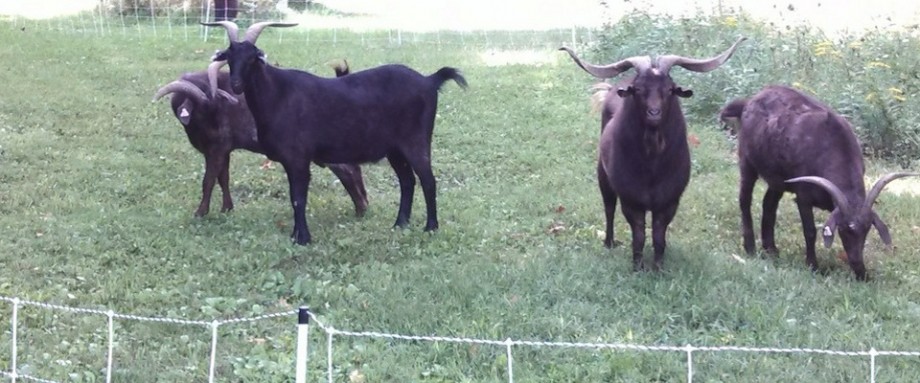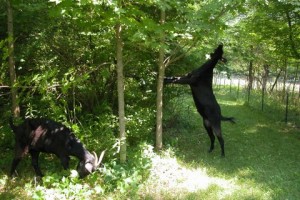A Hardy, Heritage Breed
(Photo above) Some of our male goats: bucks and wethers graze in a portable-fenced pasture.
For goat sale and rent availability & pricing information, please:
call 330-262-6109,
email info@BuckeyeRidgeFarm.com,
|
Goats for Sale
- Pets: Goats are social, and love people and other animals
- 4H Projects: Kids love Goats! Goats love Kids!
- Meat Goats: Hardy, Muscular, Delicious
- Cashmere Producers: Luxurious Fiber
- Breeding: Great, Handsome Bucks
- Ground Clearing
Rent-A-Goat
Our goats absolutely love to eat! They clear land very easily.
Why rent goats to clear land?
- No debris to dispose
- No machinery to buy or rent
- No need to apply for land clearing permits.
- Easily clear areas otherwise difficult to access, such as around trees, rough and steep terrain
Once we hear from you, one of us will visit to inspect your land, checking for any possible toxic plants. We will set up our solar-powered, electric portable fence to keep the goats in and predators out. The time it will take to clear the land depends on its size, how dense the vegetation is, and the size of the goat herd. Please be sure you have this information when you contact us for a more accurate estimate.
Armed To Teeth, Goats Keep Weeds In Check Across U.S. USA Today, August 15, 2013
Not a Baaahhhd Idea: Using Goats To Mow Your Lawn KCET Los Angeles, September 12, 2013
History of Spanish Cashmere Goats
Beginning in the 1500s Spanish goats were brought from Spain to the Caribbean Islands and from there, to the areas that would become the United States and Mexico. These foundation stocks were an undifferentiated Mediterranean type of goat that was common in Spain at the time but no longer exists. This adds genetic and historic importance to the Spanish goat breeds that evolved in the New World.
Goats flourished in the Americas. Valued as a ready source of milk, meat, and hides, they were taken everywhere the Spanish went and became an integral part of subsistence production across southern North America, Central America, and South America. The use of goats for meat was also important because it allowed cattle to be reserved for draft power, essential for crop production and transportation. Spanish goats were the only goats known across the southern United States and in most other parts of the Americas for over 300 years. There were many regional types and strains (both domestic and feral) shaped by natural selection and geographic isolation. This changed with the import of goat breeds from other countries beginning in the second half of the 1800s. The majority of Spanish goats in the United States were crossed with imported breeds for dairy production or were replaced by Angora goats for fiber production.
Today, there are relatively few purebred Spanish goats in the United States. One obstacle to the use and promotion of these goats is that the term “Spanish goats” is also used to describe crossbred and nondescript goats of the Southwest. In the Southeast, Spanish goats are also called brush, woods, and scrub goats, and these terms may include both purebred and crossbred animals.
Many people still do not understand that the Spanish goat is a pure breed; this is an easy mistake to make given the variable use of the term “Spanish” and the physical variability within the population. Fieldwork in the United States has been helpful in describing the various strains of Spanish goats and in encouraging the development of a formal network of breeders.
Interest in Spanish goats is increasing with the growth of the goat meat industry and with increased recognition of the breed’s production qualities. Spanish goats are hardy and rugged, thriving on rough forage and in difficult environments. The does are long-lived and prolific. The breed has secured a production niche in Texas, and the largest number of Spanish goat herds are found in this state. Even in Texas, however, it has become common for Spanish goats to be crossbred for meat production, especially with the Boer goat, a meat breed from South Africa. This cross shows superb hybrid vigor, but the overuse of crossbreeding could threaten the survival of pure Spanish populations. Pure Spanish goats are also being crossbred for the production of cashmere, another useful application of their characteristics but one which also removes animals from the purebred breeding group.
The Spanish goat is a landrace and varies in appearance. The goats range in weight from 50–200 pounds, with the largest animals representing strains that have been selected over many decades for meat production. Spanish goats are usually horned, and the horns on bucks may be large and twisted. The ears are large, and they are held horizontally and forward next to the head. Though the ears may be long like those of Nubians, the ear carriage is distinct, and the straight or concave face is quite different from that of the Nubian breed. Spanish goats can be any color that is found in goats, and color variation, even in single herds, can be dazzling.
The Spanish goat is a global genetic resource that is unique to the United States. The breed’s estimated population may be as large as 8,000 goats, but the challenges to its survival are imposing. For these reasons, the Spanish goat is a conservation priority in the United States.


